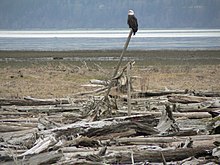Driftwood is wood that has been washed onto a shore or beach of a sea, lake, or river by the action of winds, tides or waves. It is a form of marine debris or tidewrack.
In some waterfront areas, driftwood is a major nuisance. However, the driftwood provides shelter and food for birds, fish and other aquatic species as it floats in the ocean. Gribbles, shipworms and bacteria decompose the wood and gradually turn it into nutrients that are reintroduced to the food web. Sometimes, the partially decomposed wood washes ashore, where it also shelters birds, plants, and other species. Driftwood can become the foundation for sand dunes.
A beach covered with driftwood
Most driftwood is the remains of trees, in whole or part, that have been washed into the ocean, due to flooding, high winds, or other natural occurrences, or as the result of logging. There is also a subset of driftwood known as drift lumber. Drift lumber includes the remains of man-made wooden objects, such as, buildings and their contents washed into the sea during storms, wooden objects discarded into the water from shore, dropped dunnage or lost cargo from ships (jetsam), and the remains of shipwrecked wooden ships and boats (flotsam). Erosion and wave action may make it difficult or impossible to determine the origin of a particular piece of driftwood.
Driftwood provides a perch for a bald eagle on Fir Island (Washington).
Driftwood can be used as part of decorative furniture or other art forms, and is a popular element in the scenery of fish tanks.
FireThe EPA includes driftwood in its list of "Items You Should Never Burn in Your [Wood-Burning] Appliance," because it will "release toxic chemicals when burned".
Driftwood in History
According to Norse mythology, the first humans, Ask and Embla, were formed out of two pieces of driftwood, an ash and an elm, by the god Odin and his brothers, Vili and Vé.
The Vikings would cast wood into the sea before making landfall. And the location of the wood would be an indication as to where to build their mead halls. The wood used would found the high-seat pillars of the new hall.
Driftwood carried by Arctic rivers was the main, or sometimes only, source of wood for some Inuit and other Arctic populations living north of the tree line until they came into regular contact with European traders. Traditional Inuit boats such as the kayak were fashioned from driftwood frames covered in skins. Wood that is burned today in these regions mainly consists of the remains of condemned wooden structures. Driftwood is still used as kindling by some.
The "Old Man of the Lake", in Crater Lake, Oregon is a full-size tree that has been bobbing vertically in the lake for more than a century. Due to the cold water of the lake, the tree has been well preserved.
These large diameter Sequoia sempervirens, logs spent enough time exposed to wave action to round their contours before being driven into the mouth of a narrow ravine by storm surf. Sequoia's high tannin content is resistant to decay, so these logs retain structural strength for decades. Storm flows within Shorttail Gulch are insufficient to move the logs back to sea. This unique habitat at the mouths of small estuaries of the California coast is threatened by the diminished quantity of large redwood logs available in flood waters since the logging of aboriginal forests.
Alice Gray, the legendary "Diana of the Dunes", who fought to preserve the Indiana Dunes which contain quantities of driftwood named her college "Driftwood", and made all her furniture from driftwood.
Driftwood Sculptures
Driftwood Sculptures are sculptures that are made of driftwood on beaches or mudflats :
Driftwood sculpture of a horse by artist Heather Jansch at the Eden Project.
- At Kullaberg, Sweden, Lars Vilks created Nimis a driftwood artwork in the year 1980. This sculpture and two others led to the declaration of Ladonia as an independent nation.
- Sculptures were created on the Emeryville, California mudflat and marsh area of San Francisco Bay, in the late 1960s.
- A driftwood sculpture was constructed in the Chapelle St Anne. d' Arles (France) by the visitors to the exhibition "Marcher dans le pas des glaneurs" organized by "A Flots perdus" (Arlésiens artists), in March 2008.
- The Ashden Awards for Sustainable Energy (sometimes called the "Green Oscars") are sculpted out of driftwood.
- Artist Deborah Butterfield is known for her sculptures of horses, initially rendered from driftwood before being cast in bronze.
- Artist Melanie Klaas is well known for her driftwood big game fish sculptures such as marlin and tuna as seen in Marlin

Driftwood sculpture of a locomotive in or near Emeryville, California, at the edge of the San Francisco Bay, 1977.
References
- ^ http://www.epa.gov/burnwise/bestburn.html.
- ^ pantheons and gods website. God checker.com Retrieved 09/09/2011
- ^ [1]Heathen Practices in the Viking Age
- ^ Salinas, J., "The Old Man of the Lake," Nature Notes from Crater Lake National Park, Vol. XXVII (1996).
- ^ Smith, S. & Mark, S. (2009). The Historical Roots of the Nature Conservancy in the Northwest Indiana/Chicagoland Region: From Science to Preservation. The South Shore Journal, 3. http://www.southshorejournal.org/index.php/issues/volume-3-2009/83-journals/vol-3-2009/75-the-historical-roots-of-the-nature-conservancy-in-the-northwest-indianachicagoland-region-from-science-to-preservation
- ^ Smith, S. & Mark, S. (2006). Alice Gray, Dorothy Buell, and Naomi Svihla: Preservationists of Ogden Dunes. The South Shore Journal, 1. http://www.southshorejournal.org/index.php/issues/volume-1-2006/78-journals/vol-1-2006/117-alice-gray-dorothy-buell-and-naomi-svihla-preservationists-of-ogden-dunes.
- ^ Heather Jansch - Sculptor - Driftwood - Bronze.
- ^ Deborah Butterfield on artnet.
- Wikipedia









No comments:
Post a Comment